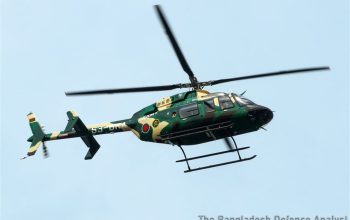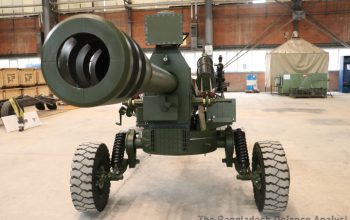The Jiangwei II class (Type 053H3) guided missile frigate is a multi-role capable coastal defence warship designed by CSIC China Ship Design & Research Centre (701 Institute). The frigates were built by CSSC Hudong-Zhonghua Shipbuilding (Group) Co., Ltd. and CSSC Guangzhou Huangpu Shipbuilding Co., Ltd with initial operational capability reached in 1998. A total of 10 warships of the class were built for the People’s Liberation Army & Navy (PLAN).
The Bangladesh Navy purchased hulls Jiaxing (521) and Lianyungang (522). Both units were built at Hudong between 1997 and 1998. They are to be renamed as BNS Umar Faruq (F16) and BNS Abu Ubaida (F19).
The Type 053H3 is armed with eight YJ-83 subsonic sea-skimming anti-ship cruise missiles (ASCM), with two quadruple launchers installed at the mid-ship position. The missile uses active radar-homing to deliver a 165 kg warhead to a range in excess of 180 km.
The primary air defence weapon is the HHQ-7 (Crotale copy) short-range SAM system, with an 8-cell launcher located on the bow deck behind the main gun and ahead of the bridge. Directed by the H/LJP-345 (Castor CTM copy) fire-control system, the missile is designed to engage aircraft in all-weather, day/night conditions at a maximum range of 8-12 km with line-of-sight guidance. The missile also has limited capability to intercept sea-skimming anti-ship missiles at a range of 4-6 km.
There are also four Type 76A dual-37mm anti-aircraft artillery guns, capable of firing 1.42 kg shells at a rate of 180 rounds per minute to a range of 8.5 km against airborne targets. The AAA guns are directed by an H/LJP-341 fire-control radar.
An H/PJ-33B (Type 79B) dual-barrel 100mm/56-calibre gun with an angular-lined turret for reduced radar cross section (RCS) is installed on the bow deck, in front of the SAM launcher. The gun is capable of firing 15 kg shells at a rate of 18 rounds per minute to a range of 22 km.
The Jiangwei II class is armed with 2 x 6-cell Type 87 240 mm anti-submarine rocket launcher, firing the Type 81G rocket-propelled depth charge with a 34 kg warhead to a range of 1,200 m, with 36 rounds. There are also 2 x depth charge racks and launchers.
Air/surface search is provided by an H/LJQ-360 radar mounted on top of the main mask. The radar operates in the E/F-band, with a maximum range of 150 km to aircraft and 50 km to sea-skimming missile.
A Type 517H-1 (‘Knife Rest’) radar working in the A-band on the aft deck provides long-range air surveillance and early warning.
The H/LJP-345 system consisting of a J-band radar and an electro-optical director (EOD) provides target direction for the HHQ-7 SAM.
A Type 343GA installed on top of bridge operating in the X- and Ku-band provides fire-control for the dual-100 mm main gun and YJ-83 anti-ship missiles. On later hulls this was replaced by an H/LJP-344A operating in the I/J-band.
An H/LJP-341 (‘Rice Lamp’) installed on top of the helicopter hangar operating in the I-band provides fire-control for the Type 76A AAA guns.
The frigate has a JM-83H electro-optical director (EOD) consisting of laser rangefinder, TV tracker, and infrared/thermal imaging, in case of electronic jamming of the gun radar.
For navigation, the frigate has two RM-1290 (Racal Decca 1290) navigation radars located on the foremast yardarms.
The frigate is equipped with an SJD-7 hull-mounted medium-frequency sonar for active/passive search and attack.
The Type 053H3 frigate’s electronic warfare suite include the RWD-8 (‘Jug Pair’) intercept, Type 981-3 jammer, SR-210 radar warning receiver, TM-053 laser warning receiver, HZ-100 electronic intelligence (ELINT) system, Type 651A IFF, two H/RJZ-946 (PJ-46) 15-barrelled 122 mm chaff/decoy launchers, and two 26-barrelled chaff launchers.
The Type 053H3 frigate is fitted with an indigenous ZJK-3C combat data system developed from the French TAVITAC. The system is based on the 10Mbps common bus architecture, and is capable of supporting operations such as air defence, anti-submarine warfare, electronic warfare, navigation, and communications. A Bangla-22 tactical data link is also likely to be installed. The system is equivalent to the NATO Link-22 and was developed by a Spanish company for the Bangladesh Navy and armed forces.
The frigate has a helicopter hangar and deck at the stern capable of operating a medium-sized helicopter, such as the Eurocopter AS 365 Panther or its Chinese copy Harbin Z-9C. The flight deck is fitted with the helicopter handling system.
The frigate is powered by a combined diesel and diesel (CODAD) arrangement, with two 18E390VA diesels rated at 14,000 hp (17.6 kW) and two MTU diesels rated at 8,840 hp (6.5 MW). Two shafts drive controllable pitch propellers. The propulsion system provides a maximum speed of 26~27 knots and, at an economical speed of 15 knots, the range is 5,000 nautical miles.
China sold the Bangladesh Navy dozens of warships including 5 guided missile frigates, 4 guided missile corvettes and various smaller missile, torpedo and gun-armed patrol/attack craft since the 1980’s.




